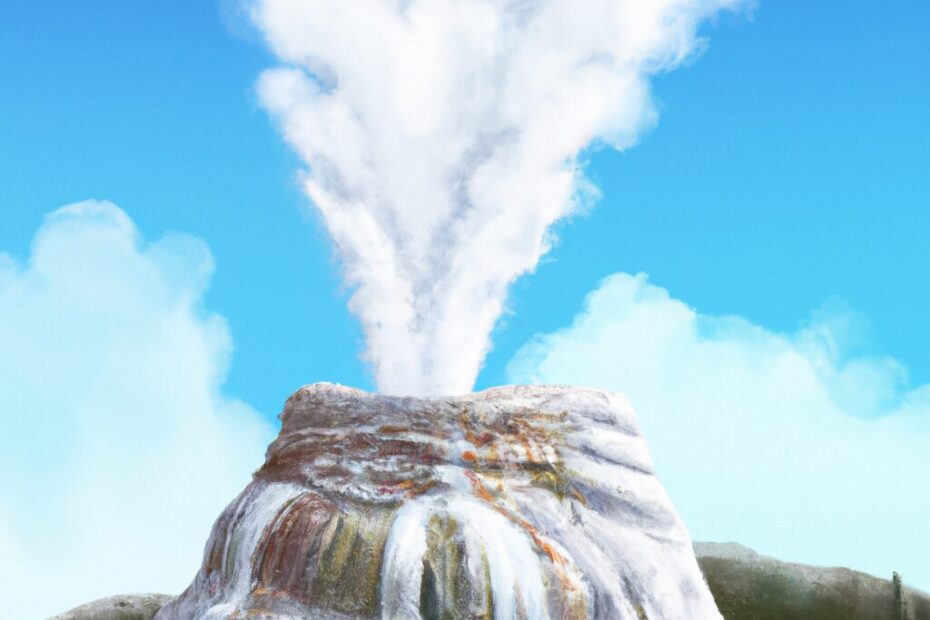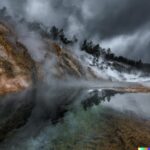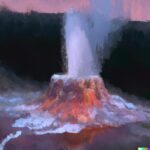Castle Geyser, one of the most iconic geysers in Yellowstone National Park, is known for its impressive eruptions. But have you ever wondered when and where this natural wonder erupts? In this article, we will explore the eruption schedule of Castle Geyser, including its average duration, frequency, and the factors that influence its schedule.
We will also delve into the history of its eruptions and provide tips on how visitors can best view this spectacular natural phenomenon. Stay tuned to learn more about the fascinating world of Castle Geyser!
What Is Castle Geyser?
Castle Geyser is a remarkable geothermal feature located in Yellowstone National Park, known for its spectacular display of eruptive activity that showcases the geological phenomenon of geysers.
With its unique formation resembling a castle turret, Castle Geyser stands out among the geysers in the park. This impressive feature erupts approximately every 10 to 12 hours, reaching heights of up to 90 feet. Its eruptions often last around 20 minutes, making it a captivating sight for visitors. The mineral-rich waters that flow from Castle Geyser leave behind colorful deposits, adding to its allure. The interaction of water and heat deep beneath the Earth’s surface creates the conditions for this natural wonder to mesmerize onlookers with its power and beauty.
Where Is Castle Geyser Located?
Castle Geyser is situated within the boundaries of Yellowstone National Park, a renowned tourist attraction celebrated for its natural beauty and diverse geothermal features, making it a must-visit destination.
Located in the Upper Geyser Basin of the park, Castle Geyser stands as a majestic testament to the raw power and beauty of nature. The geyser’s eruptions, reaching heights of up to 90 feet, awe visitors with their mesmerizing display of steam and water. Surrounding the geyser, the landscape is dotted with colorful hot springs, bubbling mud pots, and unique geological formations, creating a surreal and enchanting atmosphere that captures the essence of Yellowstone’s geothermal wonders.
What Is the Eruption Schedule of Castle Geyser?
The eruption schedule of Castle Geyser follows a predictable pattern based on historical data and geological forecasts, allowing visitors to anticipate the timing of its spectacular eruptions.
This predictability stems from the unique geological activity in the area surrounding Castle Geyser. Factors such as the subsurface plumbing system, which channels hot water and steam, play a crucial role in determining when the geyser will erupt. The eruption patterns of Castle Geyser, characterized by regular intervals between eruptions, help in making accurate predictions. By analyzing these patterns alongside geological indicators like seismic activity and heat fluctuations, researchers can better understand and forecast the geyser’s behavior, enhancing the overall visitor experience at this natural wonder.
What Is the Average Duration of Castle Geyser’s Eruption?
The average duration of Castle Geyser’s eruption typically involves a mesmerizing display of boiling water and steam that lasts for a considerable period, captivating spectators with its intense geological activity.
During its eruptions, Castle Geyser unleashes torrents of scalding water and billowing steam, reaching heights that can exceed 90 feet. The eruption cycle of Castle Geyser can last for around 20 minutes to over an hour, showcasing the dynamic forces of nature at work. This prolonged display is a result of the underground geothermal processes that create the build-up of pressure leading to the impressive release of energy during the eruption phase.
How Often Does Castle Geyser Erupt?
Castle Geyser erupts with remarkable frequency at regular intervals, showcasing its consistent geothermal activity that mesmerizes visitors with its predictable eruption cycle.
This distinct pattern of eruptions at Castle Geyser not only captivates onlookers but also provides scientists with valuable data regarding the behavior of geothermal features. The reliable rhythm of Castle Geyser’s eruptions allows researchers to study various aspects of geothermal activity, such as heat transfer mechanisms, water circulation patterns, and mineral deposition processes.
By monitoring the eruption frequency and duration of Castle Geyser, experts can gain insights into the underlying geological processes that contribute to the geyser’s periodic outbursts. Such predictability in its eruption patterns makes Castle Geyser a fascinating subject for both visitors and researchers alike.
What Time of Day Does Castle Geyser Usually Erupt?
Castle Geyser typically erupts at specific times of the day, with predicted eruption times allowing visitors to witness its spectacular display of geothermal power and natural beauty.
This popular geyser in Yellowstone National Park tends to erupt every 10 to 12 hours, making it a predictable yet awe-inspiring attraction for tourists. The optimal viewing opportunities for visitors are usually during the late morning or early afternoon when the sunlight enhances the vibrant colors of the water and steam. By checking the posted eruption schedule at the park’s visitor center or online resources, guests can plan their visit to coincide with this breathtaking natural phenomenon and capture memorable photos or videos of Castle Geyser in action.
What Are the Factors That Affect Castle Geyser’s Eruption Schedule?
Various factors influence Castle Geyser’s eruption schedule, including geothermal activity, underground reservoir dynamics, and temperature fluctuations within the hydrothermal system, shaping the timing and intensity of its eruptions.
The presence of a geothermal area around Castle Geyser plays a crucial role in fueling the underground activity that leads to its eruptions. As underground water interacts with hot rocks deep within the Earth’s crust, pressure builds up until it eventually releases in a dramatic eruption. The geological structures surrounding the geyser also influence how the water flows and accumulates before reaching the surface, affecting the eruption schedule. Understanding these intricate processes is key to predicting the behavior of Castle Geyser and other hydrothermal features in the area.
What Is the History of Castle Geyser’s Eruptions?
The history of Castle Geyser’s eruptions is a fascinating chronicle of geologic events and eruption patterns that have shaped its identity as a natural wonder within Yellowstone National Park.
It is believed that Castle Geyser’s first known eruption occurred in the late 14th century, making it one of the oldest geysers in the park. Over the centuries, this geothermal feature has displayed a unique combination of tall, impressive water columns and vibrant mineral deposits, drawing in visitors from around the world. One notable characteristic of Castle Geyser is its irregular eruption schedule, with intervals varying from several days to multiple weeks, adding an air of unpredictability to its displays. Despite its historical eruptions, Castle Geyser continues to awe and inspire with its powerful geothermal activity.
When Was the First Recorded Eruption of Castle Geyser?
The first recorded eruption of Castle Geyser dates back to a historic event that marked the beginning of its legacy as a prominent geothermal feature, showcasing the powerful forces of geologic formations in action.
This initial eruption, with its soaring columns of scalding water and steam, mesmerized early explorers and scientists alike, drawing attention to the unique geological processes at play deep beneath the earth’s surface. The eruption’s display of immense heat and pressure underscored the remarkable forces that shape the geothermal landscape of Yellowstone National Park, highlighting the delicate balance between water, heat, and underground structures that contribute to the geyser’s eruptive behavior. Castle Geyser’s historical significance lies not only in its beauty and power but also in the insight it provides into the dynamic processes that have shaped this natural wonder over millennia.
Has the Eruption Schedule of Castle Geyser Changed Over Time?
The eruption schedule of Castle Geyser has undergone changes over time due to evolving geologic processes and underground activities that have influenced the timing and characteristics of its eruptions.
These shifts in Castle Geyser’s eruption patterns are closely tied to the dynamic interplay of subsurface movements and hydrothermal manifestations within its geologic structures. The intricate balance between these factors shapes the frequency and intensity of eruptions, creating a fascinating landscape of geothermal activity. Observing these fluctuations provides valuable insights into the geologic forces at work beneath the surface and highlights the ongoing transformation of Castle Geyser’s eruptive behavior.
How Can Visitors View the Eruption of Castle Geyser?
Visitors can witness the spectacular eruption of Castle Geyser by positioning themselves at designated viewing areas that offer prime observation points to marvel at the steaming display of natural beauty and geothermal power.
These designated spots not only provide a clear view of the geyser but also allow visitors to feel the ground rumble beneath them as the powerful eruption takes place. The optimal viewing times for Castle Geyser’s eruption usually occur in the late morning or early afternoon, when the sun illuminates the spray of water, creating a mesmerizing spectacle that captivates all those lucky enough to be present. The experience of witnessing Castle Geyser in action is truly unforgettable and offers a glimpse into the raw power of nature’s wonders.
Are There Any Viewing Areas for Castle Geyser’s Eruption?
Dedicated viewing areas near Castle Geyser provide spectators with unobstructed views of the eruptive spectacle, allowing them to witness the billowing steam clouds and turbulent water displays up close.
These viewing areas are strategically positioned to offer onlookers a front-row seat to the geyser’s breathtaking shows. Visitors can feel the ground tremble beneath their feet as Castle Geyser rumbles to life, sending powerful jets of steam and water high into the air. The close proximity to the geyser’s activity creates an immersive experience where observers can truly appreciate the sheer force and beauty of nature’s volcanic phenomena. It’s a unique opportunity to connect with the earth’s powerful geothermal energy firsthand.
What Is the Best Time to View Castle Geyser’s Eruption?
The best time to view Castle Geyser’s eruption is during the predicted eruption window, minimizing the waiting time for spectators and ensuring an optimal viewing experience of the geyser’s mesmerizing display.
Located in Yellowstone National Park, Castle Geyser typically erupts every 10-12 hours, making it a spectacle not to be missed. By arriving at the geyser about an hour before its predicted window of activity, visitors can secure a prime viewing spot without enduring long waits. This strategic timing allows onlookers to capture the geyser’s powerful eruption against the backdrop of the rugged landscape, enhancing the overall experience of witnessing nature’s raw beauty.
Are There Any Special Events or Tours for Castle Geyser’s Eruption?
Special events and guided tours offer unique opportunities for visitors to explore the enchanting eruption of Castle Geyser up close, providing enhanced insights into the geyser’s geological significance and tourist appeal.
During these special events, expert guides lead participants on a journey through the natural wonders of the geyser basin, sharing fascinating facts about geothermal activity and the history of the area.
With curated tours, visitors can witness the awe-inspiring eruption of Castle Geyser while learning about its role in the larger Yellowstone ecosystem. These guided experiences not only entertain but also educate, making them ideal for families, nature enthusiasts, and anyone seeking a deeper connection to the unique features of this iconic attraction.
Last Updated on February 11, 2024 by Jon Waraas – Originally Posted: February 11, 2024

I’m Jon Waraas, and I’ve been navigating the online world since 2006. By day, I’m the proud owner of some eCommerce gems, and by night, I’m the voice behind the adventures on Waraas.Com.
My heart, however, belongs to the wild beauty of Yellowstone National Park. I’ve got a collection of websites dedicated to sharing the wonders of this natural masterpiece. Oh, and did I mention? I’m currently building my own cabin inside the ghost town of Gilmore, Idaho – a cabin with tales to tell!
When I’m not immersed in the digital realm, you’ll find me lacing up my boots for a good hike or setting up camp under the star-studded sky.




